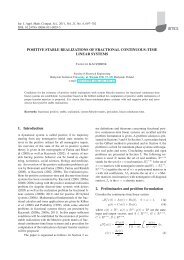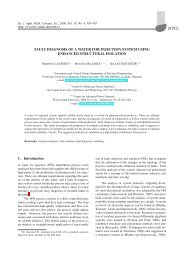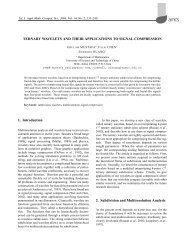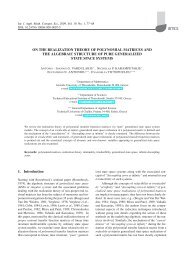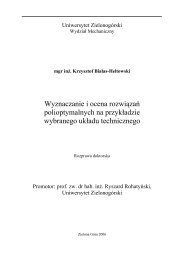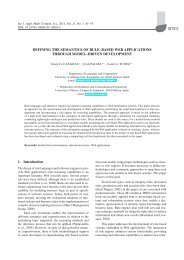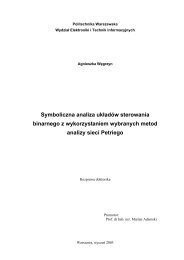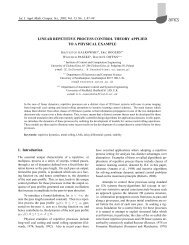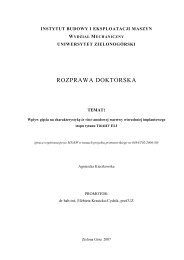Hermite Spline Interpolation on Patches for Parallelly Solving the ...
Hermite Spline Interpolation on Patches for Parallelly Solving the ...
Hermite Spline Interpolation on Patches for Parallelly Solving the ...
You also want an ePaper? Increase the reach of your titles
YUMPU automatically turns print PDFs into web optimized ePapers that Google loves.
Int. J. Appl. Math. Comput. Sci., 2007, Vol. 17, No. 3, 335–349<br />
DOI: 10.2478/v10006-007-0028-x<br />
HERMITE SPLINE INTERPOLATION ON PATCHES FOR PARALLELLY<br />
SOLVING THE VLASOV-POISSON EQUATION<br />
NICOLAS CROUSEILLES ∗ , GUILLAUME LATU ∗∗ , ERIC SONNENDRÜCKER ∗∗∗<br />
∗ INRIA Lorraine, CALVI<br />
e-mail: crouseil@math.u-strasbg.fr<br />
∗∗ INRIA Futurs, Scalapplix<br />
e-mail: latu@labri.fr<br />
∗∗∗ IRMA Strasbourg and INRIA Lorraine, CALVI<br />
e-mail: s<strong>on</strong>nen@math.u-strasbg.fr<br />
This work is devoted to <strong>the</strong> numerical simulati<strong>on</strong> of <strong>the</strong> Vlasov equati<strong>on</strong> using a phase space grid. In c<strong>on</strong>trast to Particle-<br />
In-Cell (PIC) methods, which are known to be noisy, we propose a semi-Lagrangian-type method to discretize <strong>the</strong> Vlasov<br />
equati<strong>on</strong> in <strong>the</strong> two-dimensi<strong>on</strong>al phase space. As this kind of method requires a huge computati<strong>on</strong>al ef<strong>for</strong>t, <strong>on</strong>e has to carry<br />
out <strong>the</strong> simulati<strong>on</strong>s <strong>on</strong> parallel machines. For this purpose, we present a method using patches decomposing <strong>the</strong> phase<br />
domain, each patch being devoted to a processor. Some <str<strong>on</strong>g>Hermite</str<strong>on</strong>g> boundary c<strong>on</strong>diti<strong>on</strong>s allow <strong>for</strong> <strong>the</strong> rec<strong>on</strong>structi<strong>on</strong> of a good<br />
approximati<strong>on</strong> of <strong>the</strong> global soluti<strong>on</strong>. Several numerical results dem<strong>on</strong>strate <strong>the</strong> accuracy and <strong>the</strong> good scalability of <strong>the</strong><br />
method with up to 64 processors. This work is a part of <strong>the</strong> CALVI project.<br />
Keywords: Vlasov-Poiss<strong>on</strong> equati<strong>on</strong>, semi-Lagrangian method, parallelism<br />
1. Introducti<strong>on</strong><br />
The Vlasov-Poiss<strong>on</strong> equati<strong>on</strong> describes <strong>the</strong> evoluti<strong>on</strong> of a<br />
system of charged particles subjected to <strong>the</strong> effects of a<br />
self-c<strong>on</strong>sistent electric field. The unknown f is a distributi<strong>on</strong><br />
functi<strong>on</strong> of particles in <strong>the</strong> phase space which depends<br />
<strong>on</strong> time t ≥ 0, <strong>the</strong> physical space x ∈ R d and <strong>the</strong> velocity<br />
v ∈ R d ,whered is <strong>the</strong> dimensi<strong>on</strong>, d =1, 2, 3. Thiskind<br />
of model can be used <strong>for</strong> <strong>the</strong> study of beam propagati<strong>on</strong>,<br />
collisi<strong>on</strong>less or gyrokinetic plasmas.<br />
The numerical soluti<strong>on</strong> of Vlasov-type equati<strong>on</strong>s,<br />
which depend at least <strong>on</strong> 6 variables plus time, is most<br />
often per<strong>for</strong>med using particle methods (Particle In-Cellmethods),<br />
where <strong>the</strong> plasma is approached by a finite<br />
number of macro-particles. The trajectories of <strong>the</strong>se particles<br />
are computed using <strong>the</strong> characteristic curves given by<br />
<strong>the</strong> Vlasov equati<strong>on</strong>, whereas <strong>the</strong> self-c<strong>on</strong>sistent electric<br />
field is computed <strong>on</strong> a fixed grid (Birdsall and Langd<strong>on</strong>,<br />
1991). Even though <strong>the</strong>se methods produce satisfactory<br />
results with relatively few particles, <strong>for</strong> some applicati<strong>on</strong>s<br />
(in particular, when particles in <strong>the</strong> tail of <strong>the</strong> distributi<strong>on</strong><br />
functi<strong>on</strong> play an important physical role, or when <strong>on</strong>e<br />
wants to study <strong>the</strong> influence of density fluctuati<strong>on</strong>s which<br />
are at <strong>the</strong> origin of instabilities), it is well known that <strong>the</strong><br />
numerical noise inherent in <strong>the</strong> particle methods becomes<br />
too significant. C<strong>on</strong>sequently, methods which discretize<br />
<strong>the</strong> Vlasov equati<strong>on</strong> <strong>on</strong> a phase space grid have been proposed<br />
(see (Feix et al., 1994; Filbet et al., 2001; Filbet<br />
and S<strong>on</strong>nendrücker, 2003; Ghizzo et al., 1996; Ghizzo et<br />
al., 1990; Shoucri and Knorr, 1974; S<strong>on</strong>nendrücker E. et<br />
al., 1999) <strong>for</strong> plasma physics and (Bermejo, 1991; Stani<strong>for</strong>th<br />
and Coté, 1991) <strong>for</strong> o<strong>the</strong>r applicati<strong>on</strong>s). Am<strong>on</strong>g<br />
<strong>the</strong>se Eulerian methods, <strong>the</strong> semi-Lagrangian method c<strong>on</strong>sists<br />
in computing directly <strong>the</strong> distributi<strong>on</strong> functi<strong>on</strong> <strong>on</strong> a<br />
Cartesian grid of <strong>the</strong> phase space. The computati<strong>on</strong> is<br />
d<strong>on</strong>e by integrating <strong>the</strong> characteristic curves backward at<br />
each time step and interpolating <strong>the</strong> value at <strong>the</strong> beginning<br />
of <strong>the</strong> characteristics by some interpolati<strong>on</strong> techniques<br />
(e.g., Lagrange, <str<strong>on</strong>g>Hermite</str<strong>on</strong>g> or cubic splines). We refer <strong>the</strong><br />
reader to (S<strong>on</strong>nendrücker E. et al., 1999) <strong>for</strong> more details<br />
<strong>on</strong> <strong>the</strong> semi-Lagrangian method and to (Filbet and S<strong>on</strong>nendrücker,<br />
2003) <strong>for</strong> a comparis<strong>on</strong> of Eulerian solvers<br />
dedicated to <strong>the</strong> Vlasov equati<strong>on</strong>.<br />
Eulerian methods have proven <strong>the</strong>ir efficiency <strong>on</strong><br />
uni<strong>for</strong>m meshes in <strong>the</strong> two-dimensi<strong>on</strong>al phase space,
336 N. Crouseilles et al.<br />
but when <strong>the</strong> dimensi<strong>on</strong>ality increases, <strong>the</strong> number of<br />
points <strong>on</strong> a uni<strong>for</strong>m grid becomes very important, which<br />
makes numerical simulati<strong>on</strong>s challenging. Two kinds<br />
of strategy have been recently developed to simulate<br />
four-dimensi<strong>on</strong>al problems. Some adaptive methods decrease<br />
<strong>the</strong> computati<strong>on</strong>al cost by keeping <strong>on</strong>ly a subset<br />
of all grid points. Such methods use moving distributi<strong>on</strong><br />
functi<strong>on</strong> grids well suited to manage data locality.<br />
For more details, we refer <strong>the</strong> reader to (Campos-Pinto<br />
and Merhenberger, 2004; Gutnic et al., 2004; S<strong>on</strong>nendrücker<br />
et al., 2004). On <strong>the</strong> o<strong>the</strong>r hand, some parallelized<br />
versi<strong>on</strong>s of codes were implemented to simulate<br />
high-dimensi<strong>on</strong>al problems (Coulaud et al., 1999; Filbet<br />
and Violard, 2002). Generally, <strong>the</strong> numerical schemes are<br />
based <strong>on</strong> time-splitting schemes which can be parallelized<br />
very efficiently <strong>on</strong> a moderate number of processors using<br />
a global transpositi<strong>on</strong> between each split step. Apart<br />
from this transpositi<strong>on</strong> that can be overlapped with computati<strong>on</strong>s,<br />
<strong>the</strong>re is no communicati<strong>on</strong> between <strong>the</strong> processors.<br />
However, when heterogeneous grids and several<br />
hundreds or more processors are targeted (Grandgirard et<br />
al., 2006; Kim and Parker, 2000), a global transpositi<strong>on</strong><br />
involves a huge amount of data beeing transferred and this<br />
may become very inefficient. For <strong>the</strong>se reas<strong>on</strong>s, in this paper<br />
we develop a local spline interpolati<strong>on</strong> technique that<br />
avoids any global transpositi<strong>on</strong>.<br />
This work is devoted to <strong>the</strong> parallel implementati<strong>on</strong><br />
of <strong>the</strong> semi-Lagrangian method by using <strong>the</strong> cubic spline<br />
interpolati<strong>on</strong> operator. In order to check <strong>the</strong> method, we<br />
have designed <strong>the</strong> parallel software LOSS (LOcal <str<strong>on</strong>g>Spline</str<strong>on</strong>g>s<br />
Simulator). Even though cubic spline interpolati<strong>on</strong> seems<br />
to be a good compromise between accuracy (small diffusivity)<br />
and simplicity, it does not provide <strong>the</strong> locality of<br />
<strong>the</strong> rec<strong>on</strong>structi<strong>on</strong> since all <strong>the</strong> values of <strong>the</strong> distributi<strong>on</strong><br />
functi<strong>on</strong> are used <strong>for</strong> <strong>the</strong> rec<strong>on</strong>structi<strong>on</strong> in each cell. To<br />
overcome this problem of global dependence, we decompose<br />
<strong>the</strong> phase space domain into patches, each patch being<br />
devoted to <strong>on</strong>e processor. One patch computes its own<br />
local cubic spline coefficients by solving reduced linear<br />
systems. <str<strong>on</strong>g>Hermite</str<strong>on</strong>g> boundary c<strong>on</strong>diti<strong>on</strong>s are imposed at <strong>the</strong><br />
boundary of <strong>the</strong> patches to rec<strong>on</strong>struct a global C 1 numerical<br />
soluti<strong>on</strong>.<br />
In fact, our strategy c<strong>on</strong>sists in getting a parallel versi<strong>on</strong><br />
of <strong>the</strong> code, <strong>the</strong> results of which are as close as possible<br />
to <strong>the</strong> results of <strong>the</strong> sequential versi<strong>on</strong>. Even if <strong>the</strong><br />
methodology remains slightly different from <strong>the</strong> sequential<br />
case (essentially due to <strong>the</strong> local determinati<strong>on</strong> of <strong>the</strong><br />
cubic spline coefficients versus <strong>the</strong> global soluti<strong>on</strong>), our<br />
main ef<strong>for</strong>ts c<strong>on</strong>sist in recovering <strong>the</strong> global resoluti<strong>on</strong> in<br />
<strong>the</strong> best possible way. Thanks to an adapted treatment<br />
of <strong>the</strong> <str<strong>on</strong>g>Hermite</str<strong>on</strong>g> boundary c<strong>on</strong>diti<strong>on</strong>s, <strong>the</strong> obtained numerical<br />
results are <strong>the</strong>n in good agreement with those obtained<br />
with <strong>the</strong> sequential versi<strong>on</strong> of <strong>the</strong> code. Moreover, some<br />
communicati<strong>on</strong>s between processors have to be managed<br />
in a suitable way. Indeed, as particles can leave <strong>the</strong> subdomain,<br />
<strong>the</strong>ir in<strong>for</strong>mati<strong>on</strong> must be <strong>for</strong>warded to <strong>the</strong> appropriate<br />
processor that c<strong>on</strong>trols <strong>the</strong> subdomain in which<br />
<strong>the</strong> particles now reside. Such interprocessor communicati<strong>on</strong>s<br />
would involve a relatively huge amount of data exchange,<br />
but a c<strong>on</strong>diti<strong>on</strong> <strong>on</strong> <strong>the</strong> time step allows us to c<strong>on</strong>trol<br />
<strong>the</strong> shifts so that <strong>the</strong> communicati<strong>on</strong>s are per<strong>for</strong>med<br />
<strong>on</strong>ly between adjacent processors. Hence, this communicati<strong>on</strong><br />
scheme enables us to obtain competitive results<br />
from a scalability point of view. Let us menti<strong>on</strong> that even<br />
though a uni<strong>for</strong>m grid is used here, <strong>the</strong> methodology could<br />
be extended to sets of lines which are not equally spaced<br />
(e.g., adaptive meshes).<br />
This work c<strong>on</strong>tributes to <strong>the</strong> improvement of a fivedimensi<strong>on</strong>al<br />
semi-Lagrangian gyrokinetic code which<br />
simulates <strong>the</strong> turbulent transport in magnetized fusi<strong>on</strong><br />
plasma. This high-dimensi<strong>on</strong>al problem is very demanding<br />
in terms of numerics and, <strong>the</strong>re<strong>for</strong>e, <strong>the</strong> code is<br />
devoted to be massively parallelized. A time-splitting<br />
algorithm allows us to reduce <strong>the</strong> problem into a sequence<br />
of <strong>on</strong>e-dimensi<strong>on</strong>al and two-dimensi<strong>on</strong>al advecti<strong>on</strong>s.<br />
Our method enables us to accurately solve this advecti<strong>on</strong><br />
part using parallel computati<strong>on</strong>s (see (Grandgirard<br />
et al., 2006) <strong>for</strong> more details).<br />
The paper is organized as follows: First, we draw<br />
up some basic properties of <strong>the</strong> Vlasov-Poiss<strong>on</strong> model.<br />
Then, we recall <strong>the</strong> main steps of <strong>the</strong> semi-Lagrangian<br />
method. Next, we propose <strong>the</strong> <str<strong>on</strong>g>Hermite</str<strong>on</strong>g> spline interpolati<strong>on</strong><br />
<strong>on</strong> patches be<strong>for</strong>e illustrating <strong>the</strong> efficiency of <strong>the</strong><br />
method by presenting several numerical results.<br />
2. Vlasov-Poiss<strong>on</strong> Model<br />
The evoluti<strong>on</strong> of <strong>the</strong> distributi<strong>on</strong> functi<strong>on</strong> of particles<br />
f(t, x, v) in phase space (x, v) ∈ R d ×R d with d =1, 2, 3<br />
and t denoting time is given by <strong>the</strong> dimensi<strong>on</strong>less Vlasov<br />
equati<strong>on</strong><br />
∂f<br />
∂t + v ·∇ xf + F (t, x, v) ·∇ v f =0, (1)<br />
where <strong>the</strong> <strong>for</strong>ce field F (t, x, v) can be coupled to <strong>the</strong> distributi<strong>on</strong><br />
functi<strong>on</strong> f. For <strong>the</strong> Vlasov-Poiss<strong>on</strong> system, this<br />
coupling is accomplished through <strong>the</strong> macroscopic density<br />
∫<br />
ρ(t, x) = f(t, x, v)dv.<br />
R d<br />
The <strong>for</strong>ce field which depends <strong>on</strong>ly <strong>on</strong> t and x makes <strong>the</strong><br />
system n<strong>on</strong>linear. It is given by<br />
F (t, x, v)=E(t, x), ∇ x · E(t, x)=ρ(t, x) − 1, (2)<br />
where E is <strong>the</strong> electric field and φ <strong>the</strong> electric potential.<br />
These two quantities depend <strong>on</strong> <strong>the</strong> total charge in <strong>the</strong><br />
plasma where <strong>the</strong> i<strong>on</strong>s <strong>for</strong>m a fixed and uni<strong>for</strong>m background.<br />
In <strong>the</strong> sequel, we briefly recall some classical
<str<strong>on</strong>g>Hermite</str<strong>on</strong>g> spline interpolati<strong>on</strong> <strong>on</strong> patches <strong>for</strong> parallelly solving <strong>the</strong> Vlasov-Poiss<strong>on</strong> equati<strong>on</strong><br />
337<br />
estimates regarding <strong>the</strong> Vlasov-Poiss<strong>on</strong> system (1), (2).<br />
First of all, mass and momentum are preserved in time,<br />
∫<br />
( )<br />
d<br />
1<br />
f(t, x, v) dx dv =0, t ∈ R + .<br />
dt R d ×R d v<br />
Next, multiplying <strong>the</strong> Vlasov equati<strong>on</strong> (1) by |v| 2 and<br />
integrating <strong>the</strong> result by parts, we express <strong>the</strong> c<strong>on</strong>servati<strong>on</strong><br />
of <strong>the</strong> energy <strong>for</strong> <strong>the</strong> system (1)–(2):<br />
[∫<br />
∫<br />
]<br />
1 d<br />
f(t, x, v)|v| 2 dx dv+ |E(t, x)| 2 dx =0,<br />
2 dt R d ×R d R d<br />
<strong>for</strong> all t ∈ R + . Finally, <strong>the</strong> Vlasov-Poiss<strong>on</strong> system (1)–(2)<br />
c<strong>on</strong>serves <strong>the</strong> kinetic entropy<br />
∫<br />
H(t) = f(t) log(f(t)) dx dv = H(0).<br />
R d ×R d<br />
On <strong>the</strong> o<strong>the</strong>r hand, we can define <strong>the</strong> characteristic<br />
curves of <strong>the</strong> Vlasov-Poiss<strong>on</strong> system (1)–(2) as <strong>the</strong> soluti<strong>on</strong>s<br />
to <strong>the</strong> following first-order differential system:<br />
⎧<br />
dX<br />
(t; s, x, v) = V (t; s, x, v),<br />
⎪⎨ dt<br />
(3)<br />
⎪⎩ dV<br />
dt (t; s, x, v) = E(t, X(t; s, x, v)),<br />
with <strong>the</strong> initial c<strong>on</strong>diti<strong>on</strong>s<br />
X(s; s, x, v) =x,<br />
V (s; s, x, v) =v.<br />
We denote by (X(t; s, x, v),V(t; s, x, v)) <strong>the</strong> positi<strong>on</strong> in<br />
phase space at time t, of a particle which was at (x, v) at<br />
time s. Lett → (X(t; s, x, v),V(t; s, x, v)) be <strong>the</strong> characteristic<br />
curve soluti<strong>on</strong> to (3). Then <strong>the</strong> soluti<strong>on</strong> of <strong>the</strong><br />
Vlasov-Poiss<strong>on</strong> equati<strong>on</strong> (1)–(2) is<br />
(<br />
)<br />
f(t, x, v) =f s, X(s; t, x, v),V(s; t, x, v)<br />
)<br />
= f 0<br />
(X(0; t, x, v),V(0; t, x, v) , (4)<br />
<strong>for</strong> all (x, v) ∈ R d × R d ,t ≥ 0, wheref 0 is a given<br />
initial c<strong>on</strong>diti<strong>on</strong> of <strong>the</strong> Vlasov-Poiss<strong>on</strong> equati<strong>on</strong>. This<br />
means that <strong>the</strong> distributi<strong>on</strong> functi<strong>on</strong> f is c<strong>on</strong>stant al<strong>on</strong>g<br />
<strong>the</strong> characteristic curves, which is <strong>the</strong> basis of <strong>the</strong> numerical<br />
method we present in <strong>the</strong> next secti<strong>on</strong>. For more details,<br />
we refer <strong>the</strong> reader to (Bouchut et al., 2000; Glassey,<br />
1996).<br />
3. Semi–Lagrangian Method<br />
In this secti<strong>on</strong>, we recall <strong>the</strong> principles of <strong>the</strong> Semi-<br />
Lagrangian method <strong>for</strong> <strong>the</strong> Vlasov-Poiss<strong>on</strong> equati<strong>on</strong> (see<br />
(S<strong>on</strong>nendrücker E. et al., 1999) <strong>for</strong> details) in a twodimensi<strong>on</strong>al<br />
phase space.<br />
First of all, we introduce a finite set of mesh points<br />
(x i ,v j ),i =0,...,N x and j =0,...,N v to discretize<br />
<strong>the</strong> computati<strong>on</strong>al domain. Then, given <strong>the</strong> values of <strong>the</strong><br />
distributi<strong>on</strong> functi<strong>on</strong> f at <strong>the</strong> mesh points at any given time<br />
step t n , we obtain <strong>the</strong> new value at mesh points (x i ,v j ) at<br />
t n+1 using<br />
where <strong>the</strong> notati<strong>on</strong><br />
f(t n +Δt, x i ,v j )=f(t n ,X n ,V n ),<br />
(X n ,V n )=(X(t n ; t n +Δt, x i ,v j ),V(t n ; t n +Δt, x i ,v j )<br />
is used <strong>for</strong> <strong>the</strong> soluti<strong>on</strong>s of (3), and Δt stands <strong>for</strong> <strong>the</strong> time<br />
step. For each mesh point (x i ,v j ), <strong>the</strong> distributi<strong>on</strong> functi<strong>on</strong><br />
f is <strong>the</strong>n computed at t n+1 in two steps:<br />
1. Find <strong>the</strong> starting point of <strong>the</strong> characteristic ending at<br />
(x i ,v j ), i.e., X n and V n .<br />
2. Compute f(t n ,X n ,V n ) by interpolati<strong>on</strong>, f being<br />
known <strong>on</strong>ly at mesh points at time t n .<br />
In order to deal with <strong>the</strong> first step, we have to introduce<br />
a time discretizati<strong>on</strong> of (3). To guarantee sec<strong>on</strong>dorder<br />
accuracy in time, we use <strong>the</strong> Ampère equati<strong>on</strong> to get<br />
an approximati<strong>on</strong> of <strong>the</strong> electric field at time t n +Δt,<br />
∂E(t, x)<br />
= −J(t, x), (5)<br />
∂t<br />
where J = J(t, x) is <strong>the</strong> current given by<br />
∫<br />
J(t, x) = f(t, x, v)v dv.<br />
R<br />
Equati<strong>on</strong> (5) is discretized as<br />
E n+1/2<br />
i = Ei n − Δt<br />
2 J i n ,<br />
where Δt is <strong>the</strong> time step, Ei n is <strong>the</strong> electric field evaluated<br />
at t = t n and x = x i ,andJi<br />
n is <strong>the</strong> current evaluated at<br />
time t n in x i ,<br />
∑N v<br />
Ji n = f(t n ,x i ,v j )v j Δv, (6)<br />
j=0<br />
Δv being <strong>the</strong> velocity step. Then we solve (3) with<br />
<strong>the</strong> sec<strong>on</strong>d-order accuracy in time thanks to a predictorcorrector<br />
scheme. The semi-Lagrangian method <strong>the</strong>n reduces<br />
to <strong>the</strong> following algorithm:<br />
Let us suppose that f(t n ,x i ,v j ),Ei<br />
n are known at<br />
<strong>the</strong> mesh points.<br />
Step 1. Computati<strong>on</strong> of a predicti<strong>on</strong> of E n+1/2<br />
i<br />
, denoted<br />
, through solving <strong>the</strong> Ampère equati<strong>on</strong><br />
by Ẽn+1/2 i<br />
Ẽ n+1/2<br />
i = E n i − Δt<br />
2 J n i ,<br />
where J n i is computed via (6).<br />
Step 2. Soluti<strong>on</strong> of (3):
338 N. Crouseilles et al.<br />
• Backward advecti<strong>on</strong> of Δt/2 in <strong>the</strong> spatial directi<strong>on</strong>:<br />
X n+1/2 = X n+1 − Δt<br />
2 V n+1 .<br />
• Backward advecti<strong>on</strong> of Δt in <strong>the</strong> velocity directi<strong>on</strong>:<br />
V n = V n+1 − Δt Ẽn+1/2 (X n+1/2 ).<br />
• Backward advecti<strong>on</strong> of Δt/2 in <strong>the</strong> spatial directi<strong>on</strong>:<br />
X n = X n+1/2 − Δt<br />
2 V n .<br />
Step 3. <str<strong>on</strong>g>Interpolati<strong>on</strong></str<strong>on</strong>g> of f(t n ,X n ,V n ), update of <strong>the</strong> distributi<strong>on</strong><br />
functi<strong>on</strong> owing to<br />
f(t n+1 ,X n+1 ,V n+1 )=f(t n ,X n ,V n ),<br />
and computati<strong>on</strong> of <strong>the</strong> density<br />
∫<br />
ρ n+1 (X n+1 )= f(t n+1 ,X n+1 ,v)dv.<br />
R<br />
Step 4. Correcti<strong>on</strong> step: computati<strong>on</strong> of <strong>the</strong> electric field<br />
by solving <strong>the</strong> Poiss<strong>on</strong> equati<strong>on</strong> at time t n+1 ,<br />
∂E n+1<br />
= ρ n+1 − 1.<br />
∂x<br />
Hence, Step 2 allows <strong>for</strong> <strong>the</strong> computati<strong>on</strong> of <strong>the</strong> starting<br />
point of <strong>the</strong> characteristic (X n ,V n ) thanks to <strong>the</strong><br />
knowledge of (X n+1 ,V n+1 ). Once we have followed <strong>the</strong><br />
characteristics curves backward, we have to evaluate <strong>the</strong><br />
distributi<strong>on</strong> functi<strong>on</strong> at <strong>the</strong> end points of <strong>the</strong> characteristic<br />
curves which do not generally coincide with <strong>the</strong> mesh<br />
where f is known (Step 3). The last step is a correcti<strong>on</strong><br />
step since <strong>the</strong> predicted electric field Ẽn+1 is replaced by<br />
<strong>the</strong> true electric field E n+1 at time t n+1 , <strong>the</strong> soluti<strong>on</strong> to<br />
<strong>the</strong> Poiss<strong>on</strong> equati<strong>on</strong> at time t n+1 . Let us remark that <strong>the</strong><br />
evaluati<strong>on</strong> of <strong>the</strong> electric field at time t n+1/2 in X n+1/2<br />
that does not necessarily bel<strong>on</strong>g to <strong>the</strong> mesh is per<strong>for</strong>med<br />
thanks to a linear approximati<strong>on</strong>.<br />
This algorithm may be iterated so that <strong>the</strong> predicted<br />
electric field Ẽn+1 becomes sufficiently close to <strong>the</strong> true<br />
electric field E n+1 at time t n+1 . In practice, <strong>on</strong>e iterati<strong>on</strong><br />
of this algorithm already gives enough accuracy.<br />
4. Local <str<strong>on</strong>g>Spline</str<strong>on</strong>g> <str<strong>on</strong>g>Interpolati<strong>on</strong></str<strong>on</strong>g><br />
In this secti<strong>on</strong>, we present our interpolati<strong>on</strong> technique<br />
based <strong>on</strong> a cubic spline method (DeBoor, 1978; Hammerlin<br />
and Hoffmann, 1991; S<strong>on</strong>nendrücker E. et al., 1999).<br />
Even if <strong>the</strong> cubic spline approach is quite standard <strong>for</strong><br />
solving Vlasov equati<strong>on</strong>s, it remains a global method<br />
since it requires <strong>the</strong> values of <strong>the</strong> distributi<strong>on</strong> functi<strong>on</strong> in<br />
<strong>the</strong> whole domain, which is inc<strong>on</strong>venient from a parallelizati<strong>on</strong><br />
point of view. Our approach avoids this globality.<br />
Indeed, we decompose <strong>the</strong> phase space into several<br />
patches, each being assigned to <strong>on</strong>e processor. The strategy<br />
is based <strong>on</strong> adapted boundary c<strong>on</strong>diti<strong>on</strong>s which yield<br />
a C 1 rec<strong>on</strong>structed soluti<strong>on</strong> <strong>on</strong> <strong>the</strong> global phase space domain<br />
even <strong>on</strong> <strong>the</strong> patch boundaries.<br />
We first present <strong>the</strong> interpolati<strong>on</strong> <strong>on</strong> <strong>on</strong>e patch in<br />
a <strong>on</strong>e-dimensi<strong>on</strong>al c<strong>on</strong>text be<strong>for</strong>e focusing <strong>on</strong> <strong>the</strong> twodimensi<strong>on</strong>al<br />
case.<br />
4.1. Local <str<strong>on</strong>g>Spline</str<strong>on</strong>g> <str<strong>on</strong>g>Interpolati<strong>on</strong></str<strong>on</strong>g> in One Dimensi<strong>on</strong>.<br />
C<strong>on</strong>sider a functi<strong>on</strong> f which is defined <strong>on</strong> a global domain<br />
[x min ,x max ] ⊂ R. This domain is decomposed into<br />
several subdomains denoted generically by [x 0 ,x N ]. Each<br />
subdomain will be assigned to a processor. In <strong>the</strong> following,<br />
we will use <strong>the</strong> notati<strong>on</strong> x i = x 0 + ih,whereh is <strong>the</strong><br />
mesh size h =(x N − x 0 )/(N +1).<br />
Let us now restrict <strong>the</strong> study of f : x → f(x) to<br />
an interval [x 0 ,x N ], N ∈ N, wherex 0 and x N are to<br />
be chosen according to <strong>the</strong> decompositi<strong>on</strong> domain. The<br />
projecti<strong>on</strong> s of f <strong>on</strong>to <strong>the</strong> cubic spline basis is<br />
f(x) ≃ s(x) =<br />
N+1<br />
∑<br />
ν=−1<br />
η ν B ν (x),<br />
where <strong>the</strong> cubic B-spline B ν is defined by<br />
(x − x ν−2 )<br />
⎧⎪ 3 if x ν−2 ≤ x ≤ x ν−1 ,<br />
h 3 +3h 2 (x − x ν−1 )+3h(x − x ν−1 ) 2<br />
B ν (x) = 1 ⎨ −3(x − x ν−1 ) 3 if x ν−1 ≤ x ≤ x ν ,<br />
6h 3 h 3 +3h 2 (x ν+1 − x)+3h(x ν+1 − x) 2<br />
−3(x ν+1 − x) 3 if x ν ≤ x ≤ x ν+1 ,<br />
⎪<br />
(x ν+2 − x) 3 if x ν+1 ≤ x ≤ x ν+2 ,<br />
⎩<br />
0 o<strong>the</strong>rwise.<br />
(7)<br />
The interpolating spline s is uniquely determined by N +1<br />
interpolating c<strong>on</strong>diti<strong>on</strong>s<br />
f(x i )=s(x i ), ∀i =0,...,N (8)<br />
and <strong>the</strong> <str<strong>on</strong>g>Hermite</str<strong>on</strong>g> boundary c<strong>on</strong>diti<strong>on</strong>s at both ends of <strong>the</strong><br />
interval in order to obtain a C 1 global approximati<strong>on</strong>,<br />
f ′ (x 0 ) ≃ s ′ (x 0 ), f ′ (x N ) ≃ s ′ (x N ). (9)<br />
The <strong>on</strong>ly cubic B-splines not vanishing at point x i<br />
are B i±1 (x i )=1/6 and B i (x i )=2/3. Hence, (8) yields<br />
f(x i )= 1 6 η i−1 + 2 3 η i + 1 6 η i+1, i =0,...,N. (10)<br />
On <strong>the</strong> o<strong>the</strong>r hand, we have B ′ i±1 (x i)=±1/(2h), and<br />
B ′ (x i )=0. Thus, <strong>the</strong> <str<strong>on</strong>g>Hermite</str<strong>on</strong>g> boundary c<strong>on</strong>diti<strong>on</strong>s (9)<br />
become<br />
f ′ (x 0 ) ≃ s ′ (x 0 )=−1/(2h) η −1 +1/(2h) η 1 , (11)
<str<strong>on</strong>g>Hermite</str<strong>on</strong>g> spline interpolati<strong>on</strong> <strong>on</strong> patches <strong>for</strong> parallelly solving <strong>the</strong> Vlasov-Poiss<strong>on</strong> equati<strong>on</strong><br />
339<br />
and<br />
f ′ (x N ) ≃ s ′ (x N )=−1/(2h) η N−1 +1/(2h) η N+1 .<br />
Finally, η =(η −1 ,...,η N+1 ) T is <strong>the</strong> soluti<strong>on</strong> of <strong>the</strong><br />
(N +3)× (N +3)system Aη = F ,where<br />
F =[f ′ (x 0 ),f(x 0 ),...,f(x N ),f ′ (x N )] T (12)<br />
and<br />
⎛<br />
⎞<br />
−3/h 0 3/h 0 ··· 0<br />
1 4 1 0 .<br />
A = 1 . 0 1 4 1 .. .<br />
.<br />
6<br />
. . .. . .. . .. . .. 0<br />
⎜<br />
⎟<br />
⎝ . 0 1 4 1 ⎠<br />
0 0 0 −3/h 0 3/h<br />
(13)<br />
Bear in mind that f ′ is a notati<strong>on</strong>, and from a numerical<br />
point of view, <strong>the</strong> derivative of f has to be approximated<br />
in a well-defined sense. We will focus <strong>on</strong> this in<br />
<strong>the</strong> sequel of <strong>the</strong> paper.<br />
<strong>Solving</strong> <strong>the</strong> linear system Aη = F . The matrix A of <strong>the</strong><br />
linear system has a special structure. Its LU decompositi<strong>on</strong><br />
is of <strong>the</strong> following <strong>for</strong>m:<br />
⎛<br />
⎞<br />
1 0 0 ··· ··· 0<br />
. −h/3 1 0 .. .<br />
. 0 l 1 1 .. . L=<br />
.<br />
⎜ 0 0 .. . .. 0 . ⎟<br />
⎜<br />
⎝<br />
. .. . .. lN 1 0<br />
.<br />
0 ··· 0 −(3l N )/h (3l N+1 )/h 1<br />
⎟<br />
⎠<br />
and<br />
⎛<br />
⎞<br />
−3/h 0 3/h 0 ··· 0<br />
0 d 1 2 0<br />
.<br />
U = 1 . 0 0 d 2 1 .. . ,<br />
6<br />
. 0 0 .. . .. . .. 0<br />
⎜<br />
⎝<br />
.<br />
. .. . .. . .. ⎟<br />
dN+1 1 ⎠<br />
0 ··· 0 0 0 (3d N+2 )/h<br />
where l i and d i can be computed from <strong>the</strong> following relati<strong>on</strong>s:<br />
d 1 =4,l 1 =1/4, d 2 =4− 2l 1 =7/2,<br />
<strong>for</strong> each i =2,...,N we have<br />
l i =1/d i , d i+1 =4− l i ,<br />
and<br />
l N+1 =<br />
1<br />
d N d N+1<br />
, d N+2 =1− l N+1 .<br />
The LU decompositi<strong>on</strong> of A can <strong>the</strong>n be per<strong>for</strong>med<br />
<strong>on</strong>ly <strong>on</strong>ce. At each time step, a spline interpolant needs<br />
to be computed solving LUη = F into two steps: <strong>the</strong><br />
soluti<strong>on</strong> of Lϕ = F , and <strong>the</strong>n <strong>the</strong> soluti<strong>on</strong> of Lη = ϕ.<br />
4.2. Local <str<strong>on</strong>g>Spline</str<strong>on</strong>g> <str<strong>on</strong>g>Interpolati<strong>on</strong></str<strong>on</strong>g> in Two Dimensi<strong>on</strong>s.<br />
In a two-dimensi<strong>on</strong>al space, f is projected <strong>on</strong> a cubic<br />
spline basis <strong>for</strong> every (x, y) ∈ [x 0 ,x Nx ] × [y 0 ,y Ny ] as<br />
follows:<br />
f(x, y) ≃ s(x, y) =<br />
N∑<br />
x+1<br />
N<br />
∑ y+1<br />
ν=−1 β=−1<br />
η ν,β B η (x)B β (y). (14)<br />
The same notati<strong>on</strong> as that used in <strong>the</strong> previous secti<strong>on</strong> is<br />
employed and we have to compute <strong>the</strong> coefficients η νβ .<br />
For that purpose, we first solve N y +1systems<br />
s(x, y j )=<br />
N∑<br />
x+1<br />
ν=−1<br />
γ ν (y j )B ν (x), ∀j =0,...,N y , (15)<br />
where<br />
γ ν (y j )<br />
=[γ −1 (y j ),γ 0 (y j ),...,γ ν (y j ),...,γ Nx+1(y j )] T .<br />
Each of <strong>the</strong> N y +1systems (15) satisfies N x +1interpolati<strong>on</strong><br />
c<strong>on</strong>diti<strong>on</strong>s (at fixed j)<br />
f(x i ,y j )=s(x i ,y j ), i =0,...,N x ,<br />
and <strong>the</strong> <str<strong>on</strong>g>Hermite</str<strong>on</strong>g> boundary c<strong>on</strong>diti<strong>on</strong>s in <strong>the</strong> x-directi<strong>on</strong><br />
We have<br />
∂f<br />
∂x (x 0,y j ) ≃ ∂s<br />
∂x (x 0,y j ),<br />
∂f<br />
∂x (x N x<br />
,y j ) ≃ ∂s<br />
∂x (x N x<br />
,y j ).<br />
γ ν (y j )=<br />
N<br />
∑ y+1<br />
β=−1<br />
η ν,β B β (y j ). (16)<br />
We have thus arrived at solving N y +1linear systems<br />
Aγ ν (y j ) = F (y j ), <strong>on</strong>e <strong>for</strong> each value of j, involving<br />
<strong>the</strong> (N x +3)× (N x +3)matrix (13) and an (N x +3)<br />
vector similar to (12) evaluated at y j . Following <strong>the</strong> procedure<br />
used previously (via <strong>the</strong> LU decompositi<strong>on</strong>), we<br />
<strong>the</strong>n obtain <strong>the</strong> (N x +3)vector of unknown γ ν (y j ),<strong>for</strong><br />
j =0,...,N y ,<br />
γ ν (y j )<br />
=[γ −1 (y j ),γ 0 (y j ),...,γ ν (y j ),...,γ Nx+1(y j )] T .
340 N. Crouseilles et al.<br />
The sec<strong>on</strong>d step c<strong>on</strong>sists in solving a <strong>on</strong>e dimensi<strong>on</strong>al<br />
problem given by (16) <strong>for</strong> each ν = −1,...,N x +<br />
1. However, <strong>the</strong> left-hand side of this system is <strong>on</strong>ly<br />
known <strong>for</strong> values of y j , j =0,...,N y (i.e., it is a vector<br />
of N y +1comp<strong>on</strong>ents) whereas <strong>the</strong> right-hand side is<br />
an (N y +3)vector. Some boundary c<strong>on</strong>diti<strong>on</strong>s are necessary<br />
to complete <strong>the</strong> system. <str<strong>on</strong>g>Hermite</str<strong>on</strong>g> boundary c<strong>on</strong>diti<strong>on</strong>s<br />
are imposed <strong>for</strong> <strong>the</strong> first and last comp<strong>on</strong>ents of <strong>the</strong> vector<br />
(which corresp<strong>on</strong>d to j = −1 and j = N y , respectively),<br />
that is to say, we have to compute γ ′ ν (y 0) and γ ′ ν (y N y<br />
),<br />
∀ν = −1,...,N x +1. To achieve this task, we solve two<br />
systems: we first differentiate (16) with respect to y, and<br />
<strong>the</strong>n evaluate <strong>the</strong> result at y j = y 0 and y j = y Ny . The<br />
<str<strong>on</strong>g>Hermite</str<strong>on</strong>g> boundary c<strong>on</strong>diti<strong>on</strong>s have to be adapted to this<br />
particular case. C<strong>on</strong>sequently, we have to solve <strong>the</strong> following<br />
two systems (associated with j =0and j = N y ):<br />
Aγ ′ ν(y j )=∂ y f(x, y j ),whereA is <strong>the</strong> matrix (13),<br />
γ ′ ν(y j )= [ γ ′ −1(y j ),...,γ ′ ν(y j ),...,γ ′ N x+1(y j ) ] T<br />
,<br />
and <strong>the</strong> right-hand side is<br />
∂ y f(x, y j ) = [∂ xy f(x 0 ,y j ),∂ y f(x 0 ,y j ),<br />
...,∂ y f(x i ,y j ),...,∂ xy f(x Nx ,y j )] T .<br />
Once we have computed γ ′ ν(y 0 ) and γ ′ ν(y Ny ),<strong>for</strong>all<br />
ν = −1,...,N x +1, we solve <strong>the</strong> system (16), which<br />
here takes <strong>the</strong> <strong>for</strong>m Aη ν,β =Γ νβ . The matrix A is given<br />
by (13) and <strong>the</strong> right-hand side is<br />
Γ νβ = [ γ ′ ν(y 0 ),γ ν (y 0 ),...,γ ν (y Ny ),γ ′ ν(y Ny ) ] T<br />
,<br />
<strong>for</strong> each ν = −1,...,N x +1.<br />
Once <strong>the</strong> spline coefficients η ν,β have been computed<br />
<strong>for</strong> all ν and β, <strong>the</strong>valueoff at <strong>the</strong> origin of <strong>the</strong> characteristics<br />
(X n ,V n ) (determined following <strong>the</strong> algorithm of<br />
Secti<strong>on</strong> 3) is taken to be <strong>the</strong> value of <strong>the</strong> spline s(X n ,V n ).<br />
If (X n ,V n ) bel<strong>on</strong>gs to [x i ,x i+1 ]×[y j ,y j+1 ], <strong>the</strong> approximati<strong>on</strong><br />
of <strong>the</strong> functi<strong>on</strong> f(X n ,V n ) is given by<br />
s(X n ,V n )=<br />
∑i+2<br />
ν=i−1<br />
⎛<br />
⎝<br />
∑j+2<br />
β=j−1<br />
⎞<br />
η ν,β B ν (X n )B β (V n ) ⎠ ,<br />
where B ν and B β are given by (7). Computing<br />
s(X n ,V n ) <strong>for</strong> all mesh points requires O(N x N y ) floating<br />
points operati<strong>on</strong>s.<br />
Remark 1. In summary, we have to solve<br />
• N y +1systems of size (N x +3)× (N x +3)(to get<br />
γ ν (y j ), ∀j =0,...,N y ),<br />
• 2 systems of size (N x +3)× (N x +3)(to get γ ′ ν (y 0)<br />
and γ ′ ν (y N y<br />
)),<br />
• N x +3systems of size (N y +3)× (N y +3)(to get<br />
η ν,β ).<br />
From a computati<strong>on</strong>al cost point of view, <strong>the</strong> soluti<strong>on</strong><br />
of a linear system of size N x using <strong>the</strong> LU decompositi<strong>on</strong><br />
needs O(N x ) operati<strong>on</strong>s. This procedure has to be per<strong>for</strong>med<br />
N y times <strong>for</strong> <strong>the</strong> x-directi<strong>on</strong>. The same is true <strong>for</strong><br />
<strong>the</strong> y-directi<strong>on</strong>. Finally, <strong>the</strong> two-dimensi<strong>on</strong>al interpolati<strong>on</strong><br />
leads to O(N x N y ) operati<strong>on</strong>s.<br />
4.3. Towards an Accurate Parallelizati<strong>on</strong>. In order<br />
to get accurate numerical simulati<strong>on</strong>s, <strong>on</strong>e has to take account<br />
of boundary c<strong>on</strong>diti<strong>on</strong>s <strong>for</strong> each local LU decompositi<strong>on</strong>.<br />
Indeed, our strategy c<strong>on</strong>sists in being as close as<br />
possible to <strong>the</strong> corresp<strong>on</strong>ding sequential versi<strong>on</strong>. Hence,<br />
from a decompositi<strong>on</strong> of <strong>the</strong> global domain into several<br />
patches, each processor being devoted to a patch, we want<br />
our local determinati<strong>on</strong> of cubic spline coefficients to recover<br />
in <strong>the</strong> best way a usual soluti<strong>on</strong> <strong>on</strong> <strong>the</strong> global domain.<br />
For that purpose, some ef<strong>for</strong>ts have to be made to<br />
approximate <strong>the</strong> derivatives of f in a particular way with<br />
respect to x and y. The points where derivatives must<br />
be computed are shared between two processors since x 0<br />
and x N are both beginnings and ends of subdomains (x N<br />
of <strong>the</strong> target processor corresp<strong>on</strong>ds to x 0 of <strong>the</strong> adjacent<br />
processor). Hence, <strong>the</strong>se derivatives of f join adjacent<br />
subdomains and play an important role in <strong>the</strong> quality of<br />
<strong>the</strong> numerical results (see Fig. 5).<br />
Various ways have been explored to obtain <strong>the</strong> derivatives:<br />
finite differences of different orders, cubic spline<br />
approximati<strong>on</strong>, etc. In order to rec<strong>on</strong>struct a smooth approximati<strong>on</strong><br />
(C 1 <strong>on</strong> <strong>the</strong> global domain, say), <strong>the</strong> cubic<br />
spline approximati<strong>on</strong> has been chosen. Indeed, we remark<br />
that even in regi<strong>on</strong>s where f is smooth enough, a finitedifference<br />
approximati<strong>on</strong> remains quite different from a<br />
cubic spline approximati<strong>on</strong> given by (11). Hence, as we<br />
want to rec<strong>on</strong>struct <strong>the</strong> distributi<strong>on</strong> functi<strong>on</strong> via a cubic<br />
spline approximati<strong>on</strong>, <strong>the</strong> first line of <strong>the</strong> linear system<br />
whose matrix is given by (13) can introduce some numerical<br />
errors which can be propagated in <strong>the</strong> rest of <strong>the</strong> system.<br />
In <strong>the</strong> numerical experiments we have per<strong>for</strong>med, <strong>the</strong><br />
final results are incorrect, especially when <strong>on</strong>e checks <strong>the</strong><br />
mass c<strong>on</strong>servati<strong>on</strong>. Indeed, <strong>the</strong> finite-difference approximati<strong>on</strong><br />
leads to some variati<strong>on</strong>s in <strong>the</strong> mass c<strong>on</strong>servati<strong>on</strong>,<br />
which is inc<strong>on</strong>venient <strong>for</strong> <strong>the</strong> l<strong>on</strong>g-time behavior of <strong>the</strong><br />
numerical soluti<strong>on</strong>. On <strong>the</strong> c<strong>on</strong>trary, <strong>the</strong> approximati<strong>on</strong><br />
of <strong>the</strong> derivatives using cubic splines enables us to obtain<br />
a robust code with a relatively small number of discrete<br />
points.<br />
By c<strong>on</strong>structing an approximati<strong>on</strong> of <strong>the</strong> derivatives<br />
using <strong>the</strong> cubic spline coefficients as well as Eqns. (10)<br />
and (11), we manage to overcome this kind of error (see<br />
Fig. 6). Moreover, <strong>the</strong> final global rec<strong>on</strong>structed numerical<br />
soluti<strong>on</strong> is c<strong>on</strong>sistent with a numerical soluti<strong>on</strong> which<br />
is computed through a sequential soluti<strong>on</strong>. We shall ex-
<str<strong>on</strong>g>Hermite</str<strong>on</strong>g> spline interpolati<strong>on</strong> <strong>on</strong> patches <strong>for</strong> parallelly solving <strong>the</strong> Vlasov-Poiss<strong>on</strong> equati<strong>on</strong><br />
341<br />
plain it in <strong>the</strong> following, in <strong>the</strong> <strong>on</strong>e-dimensi<strong>on</strong>al case (<strong>the</strong><br />
multi-dimensi<strong>on</strong>al case can be easily deduced). First, (11)<br />
and (10) enable us to write<br />
to obtain<br />
s ′ (x i )= 1<br />
2h (η i+1 − η i−1 ),<br />
= 1 ( 3<br />
2h 2 f i+1 − 1 4 η i − 1 4 η i+2<br />
− 3 2 f i−1 + 1 4 η i−2 + 1 )<br />
4 η i<br />
= 3<br />
4h (f i+1−f i−1 )+ 1<br />
8h (η i−2−η i+2 ) (17)<br />
s ′ (x i )= 3<br />
4h (f i+1 − f i−1 ) − 1 4 (s′ (x i−1 )+s ′ (x i+1 )).<br />
(18)<br />
Substituting (17) in (18) to compute s ′ (x i±1 ), we obtain<br />
s ′ (x i )= 3<br />
4h (f i+1 − f i−1 ) − 1 ( 3<br />
4 4h (f i+2 − f i−2 )<br />
+ 1<br />
)<br />
8h (η i−3 − η i+1 + η i−1 − η i+3 )<br />
= 3<br />
4h (f i+1 − f i−1 ) − 1 ( )<br />
3<br />
4 4h (f i+2 − f i−2 )<br />
− 1 16 (2s′ (x i )+s ′ (x i−2 )+s ′ (x i+2 )).<br />
Then we get ano<strong>the</strong>r expressi<strong>on</strong> <strong>for</strong> <strong>the</strong> derivative of s:<br />
s ′ (x i )= 6<br />
7h (f i+1 − f i−1 ) − 3<br />
14h (f i+2 − f i−2 )<br />
+ 1<br />
14 (s′ (x i+2 ) − s ′ (x i−2 )). (19)<br />
Thanks to (19), <strong>the</strong> evaluati<strong>on</strong> of s ′ (x i+2 ) and s ′ (x i−2 )<br />
leads to <strong>the</strong> following new approximati<strong>on</strong> of s ′ (x i ):<br />
αs ′ (x i )= 6<br />
7h (f i+1 − f i−1 ) − 3<br />
14h (f i+2 − f i−2 )<br />
+ 6<br />
98h (f i+3 − f i+1 + f i−1 − f i−3 )<br />
− 3<br />
14 2 h (f i+4 − f i−4 )<br />
+ 1<br />
14 2 (s′ (x i+4 ) − s ′ (x i−4 )),<br />
where α =(1− 2/14 2 ). The last iterati<strong>on</strong> allows us to<br />
obtain a high-order approximati<strong>on</strong> of <strong>the</strong> derivative of s:<br />
αs ′ (x i )<br />
8∑<br />
=<br />
j=−8<br />
ω j f i+j + 1 (<br />
)<br />
α14 2 s ′ (x i+8 )+2s ′ (x i )+s ′ (x i−8 ) ,<br />
Hence<br />
(<br />
1 − 2<br />
14 2 − 2<br />
(1 − 2/14 2 )14 2 )<br />
s ′ (x i )<br />
=<br />
∑j=8<br />
j=−8<br />
ω j f i+j + 1<br />
α14 2 (s′ (x i+8 )+s ′ (x i−8 )), (20)<br />
where <strong>the</strong> derivatives s ′ (x i+8 ) and s ′ (x i−8 ) are evaluated<br />
thanks to a finite-difference approximati<strong>on</strong> of <strong>the</strong> fourth<br />
order. For example, s ′ (x i+8 ) is approximated by<br />
s ′ (x i+8 )<br />
= −f(x i+10)+8f(x i+9 ) − 8f(x i+7 )+f(x i+6 )<br />
,<br />
12h<br />
where h is <strong>the</strong> stepsize. Even if this choice may introduce<br />
some noise in <strong>the</strong> final evaluati<strong>on</strong> of s ′ (x i ), <strong>the</strong> resulting<br />
errors remain negligible since <strong>the</strong> use of <strong>the</strong> finite differences<br />
is now sufficiently far from <strong>the</strong> juncti<strong>on</strong> points. The<br />
final approximati<strong>on</strong> of s ′ (x i ) <strong>the</strong>n becomes<br />
s ′ (x i )=<br />
=<br />
∑10<br />
j=−10<br />
∑−1<br />
j=−10<br />
˜ω j f i+j ,<br />
˜ω − j f ∑10<br />
i+j + ˜ω + j f i+j, (21)<br />
j=1<br />
since <strong>the</strong> coefficient ˜ω 0 is zero here. Note that ωj<br />
− and<br />
ω j<br />
+ are computed <strong>on</strong>ly <strong>on</strong>ce. O<strong>the</strong>r iterati<strong>on</strong>s can also be<br />
per<strong>for</strong>med, but (21) gives satisfying results.<br />
The coefficients ˜ω j , j = −10,...,10 are summarized<br />
in Table 1. The ˜ω j<br />
+ coefficients are defined as<br />
˜ω + j = −˜ω− j .<br />
Table 1. Coefficients <strong>for</strong> <strong>the</strong> approximati<strong>on</strong> of <strong>the</strong> derivatives.<br />
˜ω − −10 ˜ω − −9 ˜ω − −8 ˜ω − −7 ˜ω − −6<br />
0.22143E-5 -1.77144E-5 7.9715E-5 -3.01146E-4 1.11379E-3<br />
˜ω − −5 ˜ω − −4 ˜ω − −3 ˜ω − −2 ˜ω − −1<br />
-4.1452E-3 0.01546474 -0.05771377 0.21539034 -0.80384758<br />
5. Parallelizati<strong>on</strong> of Computati<strong>on</strong>s<br />
In order to per<strong>for</strong>m a parallelizati<strong>on</strong> of <strong>the</strong> interpolati<strong>on</strong><br />
step, data and computati<strong>on</strong> have to be distributed <strong>on</strong>to<br />
processors. A classical technique of domain decompositi<strong>on</strong><br />
is used here to split <strong>the</strong> phase space in subdomains.<br />
Thus, a single processor works <strong>on</strong> local data and shares<br />
in<strong>for</strong>mati<strong>on</strong> located <strong>on</strong> <strong>the</strong> borders of its subdomain with<br />
adjacent processors. The set of values exchanged with <strong>the</strong><br />
eight processors in <strong>the</strong> neighborhood of a given processor<br />
is named <strong>the</strong> ghost area. This area is needed because each<br />
processor has to know in<strong>for</strong>mati<strong>on</strong> bel<strong>on</strong>ging to o<strong>the</strong>rs, in<br />
order to build <strong>the</strong> right-hand side matrix of Secti<strong>on</strong> 4.2.
342 N. Crouseilles et al.<br />
The values of <strong>the</strong> functi<strong>on</strong> f and some kind of derivatives<br />
are stored in <strong>the</strong> ghost z<strong>on</strong>e in order to manage this step.<br />
From a parallel per<strong>for</strong>mance point of view, <strong>the</strong> number of<br />
values transmitted between processors must be minimal.<br />
Accordingly, <strong>the</strong> ghost z<strong>on</strong>e should be chosen as small as<br />
possible.<br />
Indeed, <strong>on</strong> <strong>the</strong> patch, <strong>on</strong>ly points (x i ,y j ) <strong>for</strong> i =<br />
0,...,N x − 1 and j = 0,...,N y − 1 are known, and<br />
<strong>the</strong> interpolati<strong>on</strong> step requires <strong>the</strong> knowledge of values<br />
<strong>on</strong> <strong>the</strong> patch borders. Moreover, we have to evaluate <strong>the</strong><br />
derivative at (x 0 ,y j ) and (x Nx ,y j ) <strong>for</strong> all j, (x i ,y 0 ),and<br />
(x i ,y Ny ) <strong>for</strong> all i, which requires (see <strong>the</strong> previous secti<strong>on</strong>)<br />
a linear combinati<strong>on</strong> of 21 points.<br />
The knowledge of <strong>the</strong>se points enables us to<br />
build and solve <strong>the</strong> LU systems, and to interpolate <strong>on</strong><br />
[x 0 ,x Nx ] × [y 0 ,y Ny ]. But we have to take into account<br />
<strong>the</strong> advected points that come from <strong>the</strong> targeted patch. As<br />
was menti<strong>on</strong>ed in <strong>the</strong> introducti<strong>on</strong>, we impose a restricti<strong>on</strong><br />
<strong>on</strong> <strong>the</strong> time step to en<strong>for</strong>ce <strong>the</strong> displacement to be lower<br />
than <strong>the</strong> cell size. Hence, <strong>the</strong> interpolati<strong>on</strong> area becomes<br />
[x 0 − Δx, x Nx +Δx] × [y 0 − Δy, y Ny +Δy] (here Δx<br />
and Δy denote <strong>the</strong> stepsizes) and additi<strong>on</strong>al cubic spline<br />
coefficients have to be computed.<br />
For that purpose, <strong>the</strong> soluti<strong>on</strong> of <strong>the</strong> linear systems<br />
described in Secti<strong>on</strong> 4.2 takes into account <strong>the</strong> augmented<br />
right-hand side matrix (23) (<strong>the</strong> derivatives are approximated<br />
in accordance with (21)).<br />
The soluti<strong>on</strong> in <strong>the</strong> x-directi<strong>on</strong> is accomplished <strong>for</strong><br />
all j, which yields <strong>the</strong> temporary spline coefficients<br />
γ ν (y j ), ν = −1,...,N x and j = −2,...,N y +1.The<br />
coefficients corresp<strong>on</strong>ding to ν = −2 and ν = N x +1are<br />
deduced from (10) <strong>for</strong> i = −1 and i = N x .<br />
In <strong>the</strong> same way, <strong>the</strong> soluti<strong>on</strong> in <strong>the</strong> y-directi<strong>on</strong> is<br />
accomplished <strong>for</strong> all ν = −2,...,N x +1, and gives <strong>the</strong><br />
coefficients η ν,β <strong>for</strong> β = −1,...,N y +1. The boundary<br />
values η ν,−2 and η ν,Ny+1 are obtained from (10).<br />
The target processor has to ga<strong>the</strong>r all points needed<br />
to <strong>for</strong>m <strong>the</strong> matrix (22). For that purpose, as <strong>the</strong> values<br />
of <strong>the</strong> distributi<strong>on</strong> functi<strong>on</strong> are known at (x i ,y j ) <strong>for</strong> i =<br />
0,...,N x −1 and j =0,...,N y −1, <strong>the</strong> local ghost z<strong>on</strong>e<br />
received from o<strong>the</strong>r processors is<br />
• f(−1,j) <strong>for</strong> j =0,...,N y − 1,<br />
• f(i, −1) <strong>for</strong> i =0,...,N x − 1,<br />
• f(N x : N x +1,j) <strong>for</strong> j =0,...,N y − 1,<br />
• f(i, N y : N y +1) <strong>for</strong> i =0,...,N x − 1,<br />
• f(−1, −1),<br />
• f(−1,N y : N y +1),<br />
Moreover, some weighted sums of 10 points are computed<br />
<strong>on</strong> <strong>the</strong> neighboring processors to evaluate all derivatives.<br />
6. Numerical Simulati<strong>on</strong>s<br />
In this secti<strong>on</strong>, some numerical results obtained with <strong>the</strong><br />
methodology we have exposed above are presented. We<br />
compare sequential and parallel simulati<strong>on</strong>s <strong>for</strong> two problems<br />
that occur in plasma physics: <strong>the</strong> Landau damping<br />
and <strong>the</strong> two-stream instability test cases.<br />
6.1. Landau Damping. In this secti<strong>on</strong>, we propose<br />
to validate <strong>the</strong> method against <strong>the</strong> standard test case of<br />
<strong>the</strong> Landau damping. We study <strong>the</strong> evoluti<strong>on</strong> of electr<strong>on</strong>s<br />
whose distributi<strong>on</strong> functi<strong>on</strong> is initially isotropic and<br />
Maxwellian of unit density and temperature. The plasma<br />
is <strong>the</strong>n perturbed and a damped periodic wave is thus created.<br />
The purpose of this numerical test is <strong>the</strong> study of <strong>the</strong><br />
evoluti<strong>on</strong> of this damped wave. To achieve this task, we<br />
c<strong>on</strong>sider <strong>the</strong> distributi<strong>on</strong> functi<strong>on</strong> of electr<strong>on</strong>s which is a<br />
soluti<strong>on</strong> to <strong>the</strong> Vlasov-Poiss<strong>on</strong> system (1)–(2).<br />
Linear Landau Damping. The initial c<strong>on</strong>diti<strong>on</strong> associated<br />
with <strong>the</strong> scaled Vlasov-Poiss<strong>on</strong> equati<strong>on</strong> (1)–(2) has<br />
<strong>the</strong> following <strong>for</strong>m:<br />
f 0 (x, v) = 1 √<br />
2π<br />
exp(−v 2 /2)(1 + α cos(kx)), (23)<br />
with (x, v) ∈ [0, 2π/k] × R, wherek is <strong>the</strong> wave number<br />
and α =0.001 is <strong>the</strong> amplitude of <strong>the</strong> perturbati<strong>on</strong>, so that<br />
we c<strong>on</strong>sider linear regimes here. To capture <strong>the</strong> Landau<br />
damping, <strong>the</strong> size of <strong>the</strong> velocity domain must be chosen<br />
greater than <strong>the</strong> phase velocity v φ . The phase velocity is<br />
equal to ω/k,whereω is <strong>the</strong> frequency related to k,which<br />
is approximated by<br />
ω 2 ≃ 1+3k 2 . (24)<br />
Then we set v max =6where <strong>the</strong> velocity domain spans<br />
from −v max to v max . We set <strong>the</strong> number of cells as N v =<br />
32 or 64 <strong>for</strong> <strong>the</strong> velocity domain, and N x =32or 64 in<br />
<strong>the</strong> spatial directi<strong>on</strong>. The time step is given by dt =0.25.<br />
The boundary c<strong>on</strong>diti<strong>on</strong>s <strong>for</strong> <strong>the</strong> distributi<strong>on</strong> functi<strong>on</strong> are<br />
periodic in <strong>the</strong> space variable and compact in <strong>the</strong> velocity<br />
directi<strong>on</strong>. Finally, <strong>the</strong> wave number is taken as k =0.3<br />
, with ω p being <strong>the</strong><br />
plasma frequency.<br />
In this test, we are interested in <strong>the</strong> evoluti<strong>on</strong> of <strong>the</strong><br />
square root of <strong>the</strong> electric energy approximated by<br />
or 0.5. The final time is T =60ω −1<br />
p<br />
• f(N x : N x +1, −1),<br />
• f(N x : N x +1,N y : N y +1).<br />
E h (t) =<br />
( ∑<br />
i<br />
E 2 i (t)Δx ) 1/2<br />
, (25)
<str<strong>on</strong>g>Hermite</str<strong>on</strong>g> spline interpolati<strong>on</strong> <strong>on</strong> patches <strong>for</strong> parallelly solving <strong>the</strong> Vlasov-Poiss<strong>on</strong> equati<strong>on</strong><br />
⎛<br />
⎜<br />
⎝<br />
f(−1, −1) ∂ y f(−1, 0) f(−1, 0) ··· f(−1,N y +1)<br />
∂ x f(0, −1) ∂xy 2 f(0, 0) ∂ xf(0, 0) ··· ∂ x f(0,N y +1)<br />
f(0, −1) ∂ y f(0, 0) f(0, 0) ··· f(0,N y +1)<br />
.<br />
.<br />
f(N x , −1) ∂ y f(N x , 0) f(N x , 0) ··· f(N x ,N y +1)<br />
∂ x f(N x , −1) ∂xy 2 f(N x, 0) ∂ x f(N x , 0) ··· ∂ x f(N x ,N y +1)<br />
f(N x +1, −1) ∂ y f(N x +1, 0) f(N x +1, 0) ··· f(N x +1,N y +1)<br />
.<br />
.<br />
343<br />
⎞<br />
. (22)<br />
⎟<br />
⎠<br />
where Δx is <strong>the</strong> space step. According to Landau’s <strong>the</strong>ory,<br />
<strong>the</strong> amplitude of E h (t) is expected to be exp<strong>on</strong>entially<br />
decreasing with frequency ω.<br />
Figure 1 presents <strong>the</strong> evoluti<strong>on</strong> of log(E h (t)) in <strong>the</strong><br />
sequential case. Two different values of <strong>the</strong> wave number<br />
are shown, namely k =0.3 and k =0.5. The number of<br />
cells is equal to N x = N v =32or N x = N v =64.We<br />
observe that E h (t) is always exp<strong>on</strong>entially decreasing, and<br />
<strong>the</strong> damping rate becomes larger when k increases, as predicted<br />
by <strong>the</strong> Landau <strong>the</strong>ory. The damping rates obtained<br />
are given by γ =0.0127 <strong>for</strong> k =0.3, andγ =0.154 <strong>for</strong><br />
k =0.5, i.e., <strong>the</strong>y are very similar to <strong>the</strong> predicted values<br />
available in <strong>the</strong> literature ((McKinstrie et al., 1999; Besse<br />
and S<strong>on</strong>nendrücker, 2003; Filbet et al., 2001)).<br />
We also observe <strong>the</strong> “recurrence effect” (Manfredi,<br />
1997): <strong>for</strong> example, in Fig. 1 (b) with N x =N v =32 points,<br />
<strong>the</strong> amplitude of <strong>the</strong> electric energy increases at t ≃<br />
31 ωp<br />
−1 , which appears to be in good agreement with <strong>the</strong><br />
<strong>the</strong>oretical time T R ≈ 2π/(kΔv). This time is predicted<br />
from <strong>the</strong> free streaming case (Δv is <strong>the</strong> velocity step).<br />
This phenomen<strong>on</strong> is alleviated by taking more points in<br />
velocity (see Fig. 1 with N x = N v =64points).<br />
In Fig. 2, <strong>the</strong> same results are shown <strong>for</strong> <strong>the</strong> parallel<br />
case. The phase space domain is decomposed into<br />
4 patches of <strong>the</strong> same size 32 × 32 points, so that <strong>the</strong><br />
global domain involves 64 × 64 points. Moreover, <str<strong>on</strong>g>Hermite</str<strong>on</strong>g><br />
boundary c<strong>on</strong>diti<strong>on</strong>s are imposed at <strong>the</strong> boundary of<br />
each patch using <strong>the</strong> approximati<strong>on</strong> (21). We can observe<br />
that <strong>the</strong> results are very similar to <strong>the</strong> sequential case since<br />
<strong>the</strong> damping rate is <strong>the</strong> same and <strong>the</strong> recurrence effect occurs<br />
at <strong>the</strong> correct time.<br />
Str<strong>on</strong>g Landau Damping. The initial datum is <strong>the</strong> following:<br />
f(0,x,v)= 1 √<br />
2π<br />
exp(−v 2 /2)(1 + α cos(kx)),<br />
where (x, v) ∈ [0, 2π/k] × R, and <strong>the</strong> amplitude of <strong>the</strong><br />
initial perturbati<strong>on</strong> in <strong>the</strong> density is α =0.5. Moreover,<br />
<strong>the</strong> wave number is k =0.5, whereas v max is equal to<br />
6.5 in order to take into account n<strong>on</strong>linear effects. The<br />
number of cells will be equal to N x = N v = 128, whereas<br />
<strong>the</strong> time step is dt =0.125.<br />
-4.6<br />
-4.8<br />
-5<br />
-5.2<br />
-5.4<br />
-5.6<br />
-5.8<br />
-6<br />
-8<br />
-10<br />
-12<br />
-14<br />
-16<br />
-6<br />
k=0.3, 32 points<br />
k=0.3, 64 points<br />
y=-0.0127<br />
0 10 20 30 40 50 60<br />
t<br />
(a)<br />
k=0.5, 32 points<br />
k=0.5, 64 points<br />
y=-0.154<br />
0 10 20 30 40 50 60<br />
t<br />
(b)<br />
Fig. 1. Electric energy as a functi<strong>on</strong> of time <strong>for</strong> <strong>the</strong> linear Landau<br />
damping in <strong>the</strong> sequential case: (a) k=0.3 with<br />
N x=N v=32 points and N x=N v=64 points, (b) k=0.5<br />
with N x=N v=32 points and N x=N v=64 points.<br />
We are also interested in <strong>the</strong> evoluti<strong>on</strong> of log(E h (t))<br />
(where E h (t) is given by (25)) as a functi<strong>on</strong> of time.<br />
The linear <strong>the</strong>ory of <strong>the</strong> previous test cannot be applied<br />
in this case since <strong>the</strong> n<strong>on</strong>linear effects have to be taken<br />
into account. Never<strong>the</strong>less, this test has been studied by<br />
several authors and comparis<strong>on</strong>s can be made with numerical<br />
results available in <strong>the</strong> literature (Besse and S<strong>on</strong>-
344 N. Crouseilles et al.<br />
-4.6<br />
k=0.3, 64 points<br />
y=-0.0127<br />
1<br />
0<br />
k=0.5, 128 points, sequential<br />
k=0.5, 128 points, parallel<br />
k=0.5, EXACT<br />
-4.8<br />
-1<br />
-5<br />
-2<br />
-5.2<br />
-3<br />
-5.4<br />
-4<br />
-5.6<br />
-5<br />
-5.8<br />
-6<br />
-6<br />
-8<br />
-6<br />
0 10 20 30 40 50 60<br />
t<br />
(a)<br />
k=0.5, 64 points<br />
y=-0.154<br />
-7<br />
0 10 20 30 40 50 60<br />
t<br />
Fig. 3. Electric energy as a functi<strong>on</strong> of time <strong>for</strong> <strong>the</strong> str<strong>on</strong>g<br />
Landau damping. Comparis<strong>on</strong> between <strong>the</strong> sequential<br />
and parallel cases, k=0.5 and N x=N v=128. An<br />
almost “exact” soluti<strong>on</strong> (512 × 1024 points) is plotted<br />
<strong>for</strong> comparis<strong>on</strong>.<br />
-10<br />
-12<br />
-14<br />
-16<br />
0 10 20 30 40 50 60<br />
t<br />
(b)<br />
Fig. 2. Electric energy as a functi<strong>on</strong> of time <strong>for</strong> <strong>the</strong> linear<br />
Landau damping in <strong>the</strong> parallel case. (a) k=0.3 with<br />
N x=N v=64 points. (b) k=0.5 with N x=N v=64 points.<br />
nendrücker, 2003; Filbet et al., 2001; Filbet and S<strong>on</strong>nendrücker,<br />
2003; Manfredi, 1997).<br />
In Fig. 3, we compare <strong>the</strong> evoluti<strong>on</strong> of <strong>the</strong> logarithm<br />
of electric energy between <strong>the</strong> sequential and parallel<br />
cases. We notice that first <strong>the</strong> amplitude of <strong>the</strong> electric<br />
energy exp<strong>on</strong>entially decreases in time, and <strong>the</strong>n oscillates<br />
around a c<strong>on</strong>stant <strong>for</strong> larger times <strong>for</strong> two simulati<strong>on</strong>s. As<br />
in <strong>the</strong> linear case, <strong>the</strong> sequential and parallel cases present<br />
quite good results compared with <strong>the</strong> results available in<br />
<strong>the</strong> literature. Moreover, until large times, <strong>the</strong> two cases<br />
do <strong>the</strong> two results<br />
become slightly different. In Fig. 3, we also plot a<br />
reference soluti<strong>on</strong> computed using 512 × 1024 points.<br />
Moreover, in Fig. 4 we can see <strong>the</strong> projecti<strong>on</strong> of <strong>the</strong><br />
distributi<strong>on</strong> functi<strong>on</strong> as a functi<strong>on</strong> of <strong>the</strong> velocity. We plot<br />
<strong>the</strong> quantity<br />
are very similar, and <strong>on</strong>ly at t ≃ 50 ω −1<br />
p<br />
F (v) =<br />
∫ 2π/k<br />
0<br />
f(x, v)dx<br />
as a functi<strong>on</strong> of <strong>the</strong> velocity <strong>for</strong> different times in <strong>the</strong> parallel<br />
case. We observe that particles whose kinetic energy<br />
is smaller than <strong>the</strong> potential energy are trapped by<br />
electrostatic waves around <strong>the</strong> phase velocity v φ = ω/k,<br />
where small bumps appear preceded by small holes. Only<br />
<strong>the</strong> parallel case is presented since <strong>the</strong> sequential results<br />
are too close to discuss differences. We can first notice<br />
that <strong>the</strong> projecti<strong>on</strong> is symmetric with respect to <strong>the</strong> origin.<br />
This is a c<strong>on</strong>sequence of <strong>the</strong> centered approximati<strong>on</strong><br />
of <strong>the</strong> derivatives (see Secti<strong>on</strong> 4.3). Indeed, uncentered<br />
approximati<strong>on</strong> using finite-difference <strong>for</strong>mulas introduces<br />
some unsymmetry in <strong>the</strong> distributi<strong>on</strong> functi<strong>on</strong> leading to<br />
a loss of accuracy. Moreover, we observe a good juncti<strong>on</strong><br />
(similar to <strong>the</strong> sequential case) of <strong>the</strong> global rec<strong>on</strong>structed<br />
distributi<strong>on</strong> functi<strong>on</strong> at v =0where a decompositi<strong>on</strong><br />
point of our parallelizati<strong>on</strong> is located. The patches<br />
are joined to each o<strong>the</strong>r by <strong>the</strong> <str<strong>on</strong>g>Hermite</str<strong>on</strong>g> boundary c<strong>on</strong>diti<strong>on</strong>s,<br />
which preserves an accurate global numerical approximati<strong>on</strong>,<br />
even though <strong>the</strong> distributi<strong>on</strong> functi<strong>on</strong> is very<br />
unstable (see, e.g., Fig. 4 at t =35ωp −1 ).<br />
Moreover, to emphasize <strong>the</strong> influence of <strong>the</strong> approximati<strong>on</strong><br />
of <strong>the</strong> derivative <strong>on</strong> <strong>the</strong> results, in Figs. 5 and 6 we<br />
plot <strong>the</strong> time evoluti<strong>on</strong> of <strong>the</strong> total relative mass. Comparis<strong>on</strong>s<br />
between <strong>the</strong> parallel and sequential cases are presented<br />
in two different c<strong>on</strong>texts. In Fig. 5, all <strong>the</strong> derivatives<br />
are approximated through <strong>the</strong> following fourth-order<br />
finite-difference operator:<br />
s ′ (x i ) ≃ −f(x i−2)+8f(x i−1 ) − 8f(x i+1 )+f(x i+2 )<br />
,<br />
12h<br />
where h is <strong>the</strong> step corresp<strong>on</strong>ding to <strong>the</strong> derivative directi<strong>on</strong>.<br />
In Fig. 6, <strong>the</strong> derivatives are replaced by <strong>the</strong> <strong>for</strong>mula<br />
(21). We can observe that <strong>the</strong> finite-difference approximati<strong>on</strong><br />
is not well suited <strong>for</strong> <strong>the</strong> parallel implementati<strong>on</strong>
<str<strong>on</strong>g>Hermite</str<strong>on</strong>g> spline interpolati<strong>on</strong> <strong>on</strong> patches <strong>for</strong> parallelly solving <strong>the</strong> Vlasov-Poiss<strong>on</strong> equati<strong>on</strong><br />
345<br />
6<br />
6<br />
5<br />
5<br />
4<br />
4<br />
3<br />
3<br />
2<br />
2<br />
1<br />
1<br />
0<br />
-6 -4 -2 0 2 4 6<br />
t<br />
(a)<br />
0<br />
-6 -4 -2 0 2 4 6<br />
t<br />
(d)<br />
6<br />
6<br />
5<br />
5<br />
4<br />
4<br />
3<br />
3<br />
2<br />
2<br />
1<br />
1<br />
0<br />
-6 -4 -2 0 2 4 6<br />
t<br />
(b)<br />
0<br />
-6 -4 -2 0 2 4 6<br />
t<br />
(e)<br />
6<br />
6<br />
5<br />
5<br />
4<br />
4<br />
3<br />
3<br />
2<br />
2<br />
1<br />
1<br />
0<br />
-6 -4 -2 0 2 4 6<br />
t<br />
(c)<br />
0<br />
-6 -4 -2 0 2 4 6<br />
t<br />
(f)<br />
Fig. 4. Time development of <strong>the</strong> spatially integrated distributi<strong>on</strong> functi<strong>on</strong> <strong>for</strong> <strong>the</strong> str<strong>on</strong>g Landau<br />
damping: <strong>the</strong> parallel case, N x = N v = 128, (a) t = 5ωp<br />
−1 , (b) t = 15ωp −1 ,<br />
(c) t =25ωp<br />
−1 , (d) t =35ωp<br />
−1 , (e) t =45ωp<br />
−1 , (f) t =60ωp −1 ..
346 N. Crouseilles et al.<br />
since <strong>the</strong> total mass presents some important oscillati<strong>on</strong>s<br />
from t ≃ 20 ωp<br />
−1 . These fluctuati<strong>on</strong>s become more significant<br />
when time increases. On <strong>the</strong> c<strong>on</strong>trary, <strong>the</strong> use of<br />
cubic spline approximati<strong>on</strong> with 21 points leads to a mass<br />
c<strong>on</strong>servati<strong>on</strong> which is very similar to <strong>the</strong> mass c<strong>on</strong>servati<strong>on</strong><br />
occuring in <strong>the</strong> sequential case. Let us remark that <strong>the</strong><br />
use of finite-difference or cubic spline approximati<strong>on</strong> does<br />
not affect <strong>the</strong> mass c<strong>on</strong>servati<strong>on</strong> in <strong>the</strong> sequential case.<br />
0.025<br />
0.02<br />
0.015<br />
0.01<br />
0.005<br />
0<br />
-0.005<br />
-0.01<br />
-0.015<br />
-0.02<br />
128 pts, finite difference derivative, parallel<br />
128pts, finite difference derivative, sequential<br />
-0.025<br />
0 10 20 30 40 50 60<br />
t<br />
Fig. 5. Comparis<strong>on</strong> between <strong>the</strong> sequential and <strong>the</strong> parallel case<br />
<strong>for</strong> <strong>the</strong> total relative mass c<strong>on</strong>servati<strong>on</strong> as a functi<strong>on</strong><br />
of time, <strong>for</strong> <strong>the</strong> str<strong>on</strong>g Landau damping. The finitedifference<br />
approximati<strong>on</strong> of fourth order is used.<br />
0<br />
-5e-05<br />
-0.0001<br />
-0.00015<br />
128pts, cubic spline derivative, parallel<br />
128pts, cubic spline derivative, sequential<br />
-0.0002<br />
0 10 20 30 40 50 60<br />
t<br />
Fig. 6. Comparis<strong>on</strong> between <strong>the</strong> sequential and parallel cases<br />
<strong>for</strong> <strong>the</strong> total relative mass c<strong>on</strong>servati<strong>on</strong> as a functi<strong>on</strong> of<br />
time <strong>for</strong> <strong>the</strong> str<strong>on</strong>g Landau damping. The cubic spline<br />
approximati<strong>on</strong> with 21 points is used.<br />
6.2. Two-Stream Instability. In this secti<strong>on</strong>, we solve<br />
<strong>the</strong> Vlasov-Poiss<strong>on</strong> equati<strong>on</strong> c<strong>on</strong>sidering <strong>the</strong> following<br />
initial datum:<br />
f(0,x,v)= √ 1 v 2 exp(−v 2 /2)(1 + α cos(kx)),<br />
2π<br />
with (x, v) ∈ [0, 2π/k] × R, where <strong>the</strong> amplitude of <strong>the</strong><br />
perturbati<strong>on</strong> is α =0.05, <strong>the</strong> wave number is k =0.5,<br />
and v max equals 9. To get a good accuracy, <strong>the</strong> number<br />
of mesh points is N x = 128 in space and N v = 128 in<br />
velocity. The final time is T = 500 ωp −1.<br />
In this model, two streams of charged particles encounter<br />
each o<strong>the</strong>r in <strong>the</strong> physical space with opposite velocities<br />
(see (Birdsall and Langd<strong>on</strong>, 1991) <strong>for</strong> more details).<br />
When evolving in time, a perturbati<strong>on</strong> occurs and<br />
grows rapidly. In <strong>the</strong> phase space, this perturbati<strong>on</strong> corresp<strong>on</strong>ds<br />
to a vortex creati<strong>on</strong> at <strong>the</strong> center of <strong>the</strong> computati<strong>on</strong>al<br />
domain.<br />
In Figs. 6 and 7, we plot <strong>the</strong> time evoluti<strong>on</strong> of <strong>the</strong> distributi<strong>on</strong><br />
functi<strong>on</strong> in <strong>the</strong> phase space in <strong>the</strong> parallel case (4<br />
patches equally decompose <strong>the</strong> phase space domain). At<br />
time t ≃ 10 ωp<br />
−1 (where ω p is <strong>the</strong> plasma frequency) we<br />
observe vortex creati<strong>on</strong> which is associated with trapped<br />
particles. From t ≃ 10 ωp<br />
−1 until t ≃ 20 ωp<br />
−1,<strong>the</strong>insta-<br />
bility grows rapidly and a hole appears. After t ≃ 20 ωp −1 ,<br />
<strong>the</strong> trapped particles oscillate in <strong>the</strong> electrostatic potential<br />
and <strong>the</strong> vortex rotates periodically. These remarks are in<br />
good agreement with <strong>the</strong> results available in (Besse and<br />
S<strong>on</strong>nendrücker, 2003; Filbet and S<strong>on</strong>nendrücker, 2003).<br />
This simulati<strong>on</strong> is quite interesting since <strong>the</strong> hole has<br />
to stay in <strong>the</strong> middle of <strong>the</strong> computati<strong>on</strong>al domain during<br />
all <strong>the</strong> simulati<strong>on</strong>s. A displacement of this centered vortex<br />
can occur due to a failed numerical soluti<strong>on</strong> <strong>for</strong> large<br />
times. Here again, <strong>the</strong> good mass c<strong>on</strong>servati<strong>on</strong> depends<br />
<strong>on</strong> <strong>the</strong> derivative approximati<strong>on</strong>, as explained previously.<br />
In particular, we remarked that finite-difference approximati<strong>on</strong>s<br />
(even centered <strong>on</strong>es) lead to uncorrect results <strong>for</strong><br />
large times (<strong>the</strong> hole comes out early). Moreover, <strong>the</strong> inherent<br />
precisi<strong>on</strong> of <strong>the</strong> cubic spline interpolati<strong>on</strong> allows us<br />
to follow thin filaments developed by <strong>the</strong> soluti<strong>on</strong>. Even<br />
if <strong>the</strong> methodology which enables <strong>the</strong> parallelizati<strong>on</strong> is<br />
slightly different from <strong>the</strong> sequential versi<strong>on</strong>, we observe<br />
that <strong>the</strong> parallelizati<strong>on</strong> does not affect <strong>the</strong> precisi<strong>on</strong> due to<br />
<strong>the</strong> spline interpolati<strong>on</strong>.<br />
Finally, several tests have been implemented to<br />
evaluate <strong>the</strong> influence of <strong>the</strong> number of processors <strong>on</strong> <strong>the</strong><br />
numerical results and <strong>on</strong> <strong>the</strong> simulati<strong>on</strong> time. The number<br />
of points in each patch has to be substantial (<strong>for</strong> small<br />
patches, <strong>the</strong> overhead in computati<strong>on</strong>s to estimate <strong>the</strong><br />
derivatives becomes too large). The per<strong>for</strong>mance of <strong>the</strong><br />
parallel algorithm is summarized in Tables 2 and 3 <strong>for</strong> <strong>the</strong><br />
two-stream instability implemented with N x = N v = 512<br />
points. The experiments were c<strong>on</strong>ducted <strong>on</strong> two parallel
<str<strong>on</strong>g>Hermite</str<strong>on</strong>g> spline interpolati<strong>on</strong> <strong>on</strong> patches <strong>for</strong> parallelly solving <strong>the</strong> Vlasov-Poiss<strong>on</strong> equati<strong>on</strong><br />
347<br />
t=0wp<br />
t=10wp<br />
t=16wp<br />
10<br />
8<br />
6<br />
4<br />
2<br />
0<br />
-2<br />
-4<br />
0.35<br />
0.3<br />
0.25<br />
0.2<br />
0.15<br />
0.1<br />
0.05<br />
0<br />
-0.05<br />
-0.1<br />
10<br />
8<br />
6<br />
4<br />
2<br />
0<br />
-2<br />
-4<br />
0.35<br />
0.3<br />
0.25<br />
0.2<br />
0.15<br />
0.1<br />
0.05<br />
0<br />
-0.05<br />
-0.1<br />
10<br />
8<br />
6<br />
4<br />
2<br />
0<br />
-2<br />
-4<br />
0.35<br />
0.3<br />
0.25<br />
0.2<br />
0.15<br />
0.1<br />
0.05<br />
0<br />
-0.05<br />
-0.1<br />
-6<br />
-6<br />
-6<br />
-8<br />
-8<br />
-8<br />
102468<br />
-10<br />
0 2 4 6 8 10 12 14<br />
102468<br />
-10<br />
0 2 4 6 8 10 12 14<br />
102468<br />
-10<br />
0 2 4 6 8 10 12 14<br />
(a) (b) (c)<br />
t=20wp<br />
t=26wp<br />
t=30wp<br />
10<br />
8<br />
6<br />
4<br />
2<br />
0<br />
-2<br />
-4<br />
0.35<br />
0.3<br />
0.25<br />
0.2<br />
0.15<br />
0.1<br />
0.05<br />
0<br />
-0.05<br />
-0.1<br />
10<br />
8<br />
6<br />
4<br />
2<br />
0<br />
-2<br />
-4<br />
0.5<br />
0.4<br />
0.3<br />
0.2<br />
0.1<br />
0<br />
-0.1<br />
10<br />
8<br />
6<br />
4<br />
2<br />
0<br />
-2<br />
-4<br />
0.4<br />
0.35<br />
0.3<br />
0.25<br />
0.2<br />
0.15<br />
0.1<br />
0.05<br />
0<br />
-0.05<br />
-0.1<br />
-6<br />
-6<br />
-6<br />
-8<br />
-8<br />
-8<br />
102468<br />
0 2 4 6 8 10 12 14 -10<br />
102468<br />
0 2 4 6 8 10 12 14 -10<br />
102468<br />
0 2 4 6 8 10 12 14 -10<br />
(d) (e) (f)<br />
t=50wp<br />
t=100wp<br />
t=200wp<br />
10<br />
8<br />
6<br />
4<br />
2<br />
0<br />
-2<br />
-4<br />
0.35<br />
0.3<br />
0.25<br />
0.2<br />
0.15<br />
0.1<br />
0.05<br />
0<br />
-0.05<br />
-0.1<br />
10<br />
8<br />
6<br />
4<br />
2<br />
0<br />
-2<br />
-4<br />
0.35<br />
0.3<br />
0.25<br />
0.2<br />
0.15<br />
0.1<br />
0.05<br />
0<br />
-0.05<br />
-0.1<br />
10<br />
8<br />
6<br />
4<br />
2<br />
0<br />
-2<br />
-4<br />
0.35<br />
0.3<br />
0.25<br />
0.2<br />
0.15<br />
0.1<br />
0.05<br />
0<br />
-0.05<br />
-0.1<br />
-6<br />
-6<br />
-6<br />
-8<br />
-8<br />
-8<br />
102468<br />
-10<br />
0 2 4 6 8 10 12 14<br />
102468<br />
-10<br />
0 2 4 6 8 10 12 14<br />
102468<br />
-10<br />
0 2 4 6 8 10 12 14<br />
(g) (h) (i)<br />
t=500wp<br />
10<br />
8<br />
6<br />
4<br />
2<br />
0<br />
-2<br />
-4<br />
-6<br />
-8<br />
102468<br />
0 2 4 6 8 10 12 14 -10<br />
0.3<br />
0.25<br />
0.2<br />
0.15<br />
0.1<br />
0.05<br />
0<br />
-0.05<br />
-0.1<br />
(j)<br />
Fig. 7. Evoluti<strong>on</strong> of <strong>the</strong> distributi<strong>on</strong> functi<strong>on</strong> f in <strong>the</strong> phase space with N x = 128 and N v = 128 in <strong>the</strong><br />
parallel case (4 processors are used), <strong>for</strong> <strong>the</strong> two stream instability: (a) t =0ωp<br />
−1 , (b) t =10ωp −1 ,<br />
(c) t = 16ωp<br />
−1 , (d) t = 20ωp<br />
−1 , (e) t = 26ωp<br />
−1 , (f) t = 30ωp<br />
−1 , (g) t = 50ωp −1 , (h) t =<br />
100 ωp<br />
−1 , (i) t = 200 ωp<br />
−1 , (j) t = 500 ωp −1 .
348 N. Crouseilles et al.<br />
Table 2. Speedup <strong>for</strong> <strong>the</strong> two-stream instability <strong>on</strong> a shared<br />
memory SGI machine. The results corresp<strong>on</strong>ds to<br />
512 × 512 points in <strong>the</strong> phase space. The simulati<strong>on</strong><br />
was stopped after 300 iterati<strong>on</strong>s.<br />
Processors 1 4 8 16 32 64<br />
Time [s.] 40 9.4 4.7 2.4 1.2 0.7<br />
Speedup 1 4.25 8.51 16.6 33.3 57.14<br />
Table 3. Speedup <strong>for</strong> <strong>the</strong> two-stream instability <strong>on</strong> a cluster of<br />
11 IBM nodes. The results corresp<strong>on</strong>ds to 512 × 512<br />
points in <strong>the</strong> phase space. The simulati<strong>on</strong> was stopped<br />
after 300 iterati<strong>on</strong>s.<br />
Processors 1 4 8 16 32 64<br />
Time (s.) 89.2 19.4 9.7 4.9 2.6 1.6<br />
Speedup 1 4.6 9.2 18.2 34.3 55.75<br />
machines: a cluster 1 of 11 IBM nodes (16-way Power5<br />
processors at 1.9 GHz) and a shared memory SGI machine<br />
2 of 512 processors (Origin 3800 with 500 MHz<br />
processors). Let us menti<strong>on</strong> that <strong>the</strong> results presented in<br />
Tables 2 and 3 do not take into account <strong>the</strong> diagnostics<br />
computati<strong>on</strong>s.<br />
Our speedup is quite good since it takes into account<br />
<strong>the</strong> numerical soluti<strong>on</strong> of <strong>the</strong> Poiss<strong>on</strong> equati<strong>on</strong>. Indeed,<br />
after each two-dimensi<strong>on</strong>al advecti<strong>on</strong> in <strong>the</strong> phase space,<br />
<strong>the</strong> Poiss<strong>on</strong> equati<strong>on</strong> has to be globally solved (<strong>the</strong> corrector<br />
part of <strong>the</strong> algorithm, c.f. Secti<strong>on</strong> 3). This step is<br />
time c<strong>on</strong>suming when <strong>the</strong> number of processor increases.<br />
Never<strong>the</strong>less, our methodology focuses <strong>on</strong> <strong>the</strong> interpolati<strong>on</strong><br />
step. In particular, we believe that higher-dimensi<strong>on</strong>al<br />
problems will improve <strong>the</strong> speedup since we will per<strong>for</strong>m<br />
communicati<strong>on</strong>-computati<strong>on</strong> overlap easily in <strong>the</strong> fourdimensi<strong>on</strong>al<br />
cases. Let us remark that <strong>the</strong> decompositi<strong>on</strong><br />
of <strong>the</strong> global domain affects nei<strong>the</strong>r <strong>the</strong> numerical results,<br />
nor <strong>the</strong> length of <strong>the</strong> simulati<strong>on</strong>.<br />
7. C<strong>on</strong>clusi<strong>on</strong><br />
In this paper, we introduced a local semi-Lagrangian<br />
method which has been applied to <strong>the</strong> Vlasov-Poiss<strong>on</strong><br />
equati<strong>on</strong>. The methodology seems to present a good behaviour<br />
when tested <strong>on</strong> standard plasma c<strong>on</strong>figurati<strong>on</strong>s.<br />
Indeed, <strong>the</strong> numerical results dem<strong>on</strong>strade <strong>the</strong> good efficiency<br />
of our code <strong>for</strong> <strong>the</strong> two-dimensi<strong>on</strong>al case and its<br />
good scalability with up to 64 processors.<br />
Using <strong>the</strong> method introduced here, we developed a<br />
Fortran 90 module to locally interpolate any advected<br />
functi<strong>on</strong> <strong>on</strong> a two-dimensi<strong>on</strong>al domain. This module will<br />
<strong>the</strong>n enable us to deal with many problems occuring in<br />
1 The IBM machine bel<strong>on</strong>gs to <strong>the</strong> M3PEC group, Bordeaux 1<br />
University.<br />
2 The SGI machine is located in M<strong>on</strong>tpellier, France, in <strong>the</strong> computing<br />
center CINES http://www.cines.fr.<br />
plasma physics using <strong>the</strong> semi-Lagrangian methodology.<br />
Future extensi<strong>on</strong>s will be devoted to <strong>the</strong> paraxial Vlasov<br />
model. Moreover, coupling this methodology with <strong>the</strong><br />
moving grid strategy can also be envisaged. Finally, a new<br />
algorithm that overcomes <strong>the</strong> restricti<strong>on</strong> <strong>on</strong> <strong>the</strong> time step<br />
has to be developed later <strong>on</strong>.<br />
Acknowledgements<br />
Support by Commissariat à l’énergie atomique (CEA-<br />
Cadarache) is acknowledged. The authors wish to thank<br />
<strong>the</strong> CINES center and <strong>the</strong> Bordeaux 1 University <strong>for</strong> time<br />
allocati<strong>on</strong> <strong>on</strong> <strong>the</strong>ir computers.<br />
References<br />
Bermejo R. (1991): Analysis of an algorithm <strong>for</strong> <strong>the</strong> Galerkincharacteristic<br />
method. Numerische Ma<strong>the</strong>matik, Vol. 60,<br />
pp. 163–194.<br />
Besse N. and S<strong>on</strong>nendrücker E. (2003): Semi-Lagrangian<br />
schemes <strong>for</strong> <strong>the</strong> Vlasov equati<strong>on</strong> <strong>on</strong> an unstructured<br />
mesh of phase space. Journal of Computati<strong>on</strong>al Physics,<br />
Vol. 191, pp. 341–376.<br />
Birdsall C.K. and Langd<strong>on</strong> A.B.: Plasma Physics via Computer<br />
Simulati<strong>on</strong>. Bristol: Institute of Physics Publishing.<br />
Bouchut F., Golse F. and Pulvirenti M. (2000): Kinetic Equati<strong>on</strong>s<br />
and Asymptotic Theory. Paris: Gauthier-Villars.<br />
DeBoor C. (1978): A Practical Guide to <str<strong>on</strong>g>Spline</str<strong>on</strong>g>s. New-York:<br />
Springer.<br />
Campos-Pinto M. and Merhenberger M. (2004): Adaptive Numerical<br />
Resoluti<strong>on</strong> of <strong>the</strong> Vlasov Equati<strong>on</strong>.<br />
Cheng C.Z. and Knorr G. (1976): The integrati<strong>on</strong> of <strong>the</strong> Vlasov<br />
equati<strong>on</strong> in c<strong>on</strong>figurati<strong>on</strong> space. Journal of Computati<strong>on</strong>al<br />
Physics, Vol. 22, p. 330.<br />
Coulaud O., S<strong>on</strong>nendrücker E., Dill<strong>on</strong> E., Bertrand P. and<br />
Ghizzo A. (1999): Parallelizati<strong>on</strong> of semi-Lagrangian<br />
Vlasov codes. Journal of Plasma Physics, Vol. 61, pp. 435–<br />
448.<br />
Feix M.R., Bertrand P. and Ghizzo A. (1994): Title In: Kinetic<br />
Theory and Computing, (B. Perthame, Ed.).<br />
Filbet F., S<strong>on</strong>nendrücker E. and Bertrand P. (2001): C<strong>on</strong>servative<br />
numerical schemes <strong>for</strong> <strong>the</strong> Vlasov equati<strong>on</strong>. Journal of<br />
Computati<strong>on</strong>al Physics, Vol. 172, pp. 166–187.<br />
Filbet F. and S<strong>on</strong>nendrücker E. (2003): Comparis<strong>on</strong> of<br />
Eulerian Vlasov solvers. Computer Physics Communicati<strong>on</strong>s,<br />
Vol. 151, pp. 247–266.<br />
Filbet F. and Violard E. (2002): Parallelizati<strong>on</strong> of a<br />
Vlasov Solver by Communicati<strong>on</strong> Overlapping. Proceedings<br />
PDPTA.<br />
Glassey R.T. (1996): The Cauchy Problem in Kinetic Theory.<br />
Philadelphia, PA: SIAM.<br />
Ghizzo A., Bertrand P., Begue M.L., Johnst<strong>on</strong> T.W. and Shoucri<br />
M. (1996): A Hilbert-Vlasov code <strong>for</strong> <strong>the</strong> study of highfrequency<br />
plasma beatwave accelerator. IEEE Transacti<strong>on</strong>s<br />
<strong>on</strong> Plasma Science, Vol. 24.
<str<strong>on</strong>g>Hermite</str<strong>on</strong>g> spline interpolati<strong>on</strong> <strong>on</strong> patches <strong>for</strong> parallelly solving <strong>the</strong> Vlasov-Poiss<strong>on</strong> equati<strong>on</strong><br />
349<br />
Ghizzo A., Bertrand P., Shoucri M., Johnst<strong>on</strong> T.W., Filjakow<br />
E. and Feix M.R. (1990): A Vlasov code <strong>for</strong> <strong>the</strong> numerical<br />
simulati<strong>on</strong> of stimulated Raman scattering. Journal of<br />
Computati<strong>on</strong>al Physis, Vol. 90, pp. 431–457.<br />
Grandgirard V., Brunetti M., Bertrand P., Besse N., Garbet<br />
N., Ghendrih P., Manfredi G., Sarrazin Y., Sauter O.,<br />
S<strong>on</strong>nendrücker E., Vaclavik J. and Villard L. (2006): A<br />
drift-kinetic semi-Lagrangian 4D code <strong>for</strong> i<strong>on</strong> turbulence<br />
simulati<strong>on</strong>. Journal of Computati<strong>on</strong>al Physics, Vol. 217,<br />
pp. 395–423.<br />
Gutnic M., Haefele M., Paun I. and S<strong>on</strong>nendrücker E. (2004):<br />
Vlasov simulati<strong>on</strong> <strong>on</strong> an adaptive phase space grid. Computer<br />
Physical Communicati<strong>on</strong>s, Vol. 164, pp. 214–219.<br />
Hammerlin G. and Hoffmann K.H. (1991): Numerical Ma<strong>the</strong>matics,<br />
New-York: Springer.<br />
Kim C.C. and Parker S.E. (2000): Massively parallel threedimensi<strong>on</strong>al<br />
toroidal gyrokinetic flux-tube turbulence simulati<strong>on</strong>.<br />
Journal of Computati<strong>on</strong>al Physics, Vol. 161,<br />
pp. 589–604.<br />
McKinstrie C.J., Giac<strong>on</strong>e R.E. and Startsev E.A. (1999): Accurate<br />
<strong>for</strong>mulas <strong>for</strong> <strong>the</strong> Landau damping rates of electrostatic<br />
waves. Physics of Plasmas, Vol. 6, pp. 463–466.<br />
Manfredi G. (1997): L<strong>on</strong>g time behaviour of str<strong>on</strong>g linear Landau<br />
damping. Physical Review Letters, Vol. 79.<br />
Shoucri M. and Knorr G. (1974): Numerical integrati<strong>on</strong> of<br />
<strong>the</strong> Vlasov equati<strong>on</strong>. Journal of Computati<strong>on</strong>al Physics,<br />
Vol. 14, pp. 84–92.<br />
S<strong>on</strong>nendrücker E., Filbet F., Friedman A., Oudet E. and Vay J.L.<br />
(2004): Vlasov simulati<strong>on</strong> of beams <strong>on</strong> a moving phase<br />
space grid. Computer Physics Communicati<strong>on</strong>s, Vol. 164,<br />
pp. 390–395.<br />
S<strong>on</strong>nendrücker E., Roche J., Bertrand P. and Ghizzo A. (1999):<br />
The semi-Lagrangian method <strong>for</strong> <strong>the</strong> numerical resoluti<strong>on</strong><br />
of <strong>the</strong> Vlasov equati<strong>on</strong>s. Journal of Computati<strong>on</strong>al Physics,<br />
Vol. 149, pp. 201–220.<br />
Stani<strong>for</strong>th A. and Coté J. (1991): Semi-Lagrangian integrati<strong>on</strong><br />
schemes <strong>for</strong> atmospheric models – A review. M<strong>on</strong>thly<br />
Wea<strong>the</strong>r Review, Vol. 119, pp. 2206–2223.




